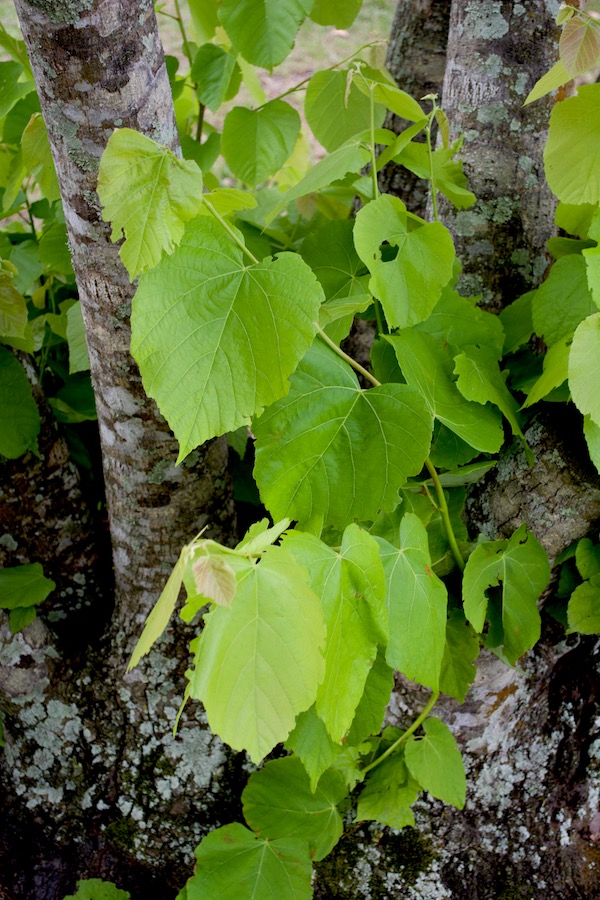
There’s an odd kind of mulberry here in Florida. I suspect it’s an old cultvar. The leaves are pointy and there are no “thumbs” on any of the leaves. A Basswood tree — above — can look similar at first glance from a distance. But the species are quite different. We saw both this past week during a foraging class mid-state in Ft. Meade (not to be confused with Mead Garden.) Most of the Mulberry fruit was not yet ripe.

The Basswood tree and I go back more than 60 years as you can read in the attached article below. It offers a number of edibles and has a wide growth range. It was a very common tree where I grew up in Maine. My step-father’s Brother-in-Law owned a few hundred acres of mostly hardwood about a mile from where we lived. When we needed wild wood for this or that to the forest we went. (That’s where I learned some wood is easy to size up for the stove — straight-grained white pine and ash — and other woods nearly impossible among them twisted elm and hackmatack. That latter is one of the few conifers that loses its needles in the winter. We used wild trees — mostly ash — to make or repair head blocks, draw bars, shafts, and whiffletrees on carriages, pitmans on mowers.)
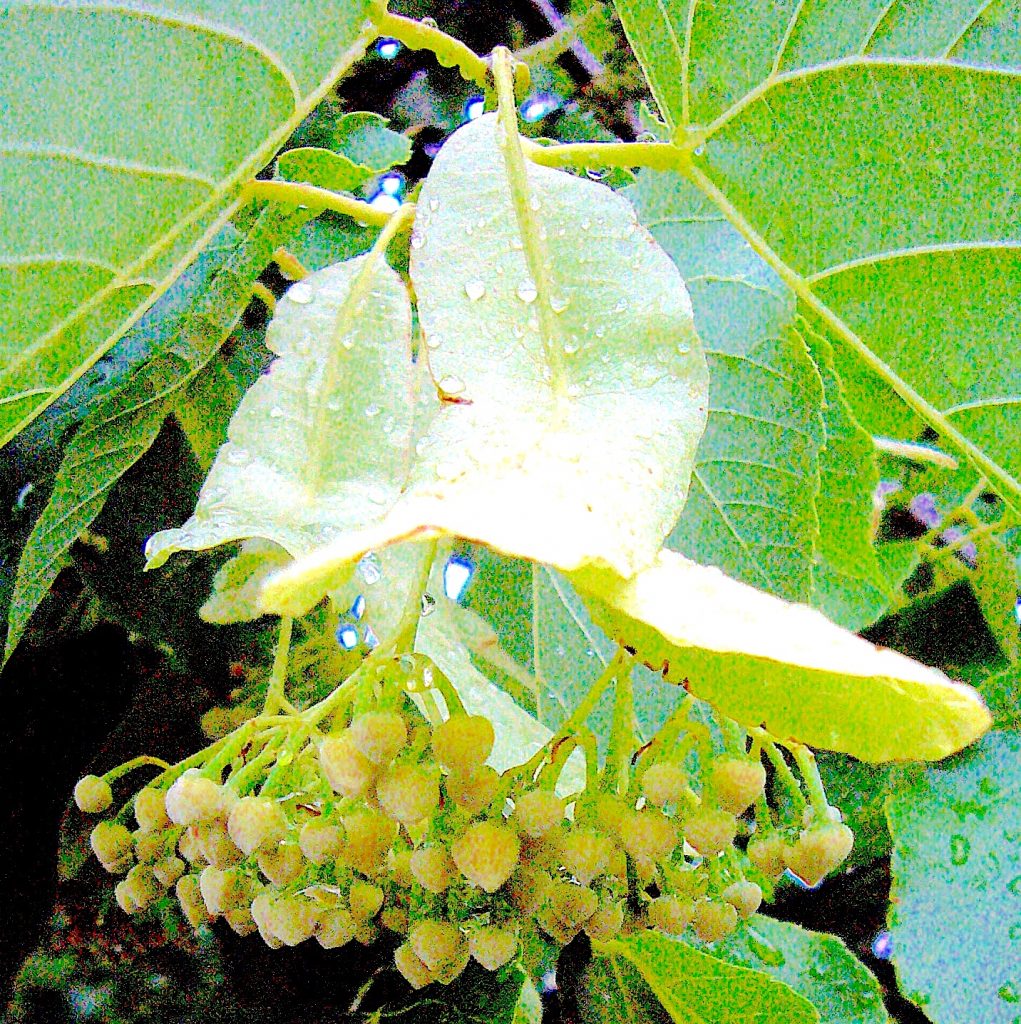
One reason why I like Basswood is when it is flowering it’s nearly impossible to misidentify (if you are close enough.) A lot of people are intimidated by trees but as a group trees are the easiest of wild edibles to identify. There aren’t that many and they are easy to study. You can look at them all day for years unlike some mushrooms that are gone in days if not hours. Basswood blossoms are accompanied by a growth that looks like a tongue depressor (upper right.) It’s just about unique in having that and there is much about the tree that is edible especially in the spring. It is also a good source of fiber. To read more about the Basswood go here.
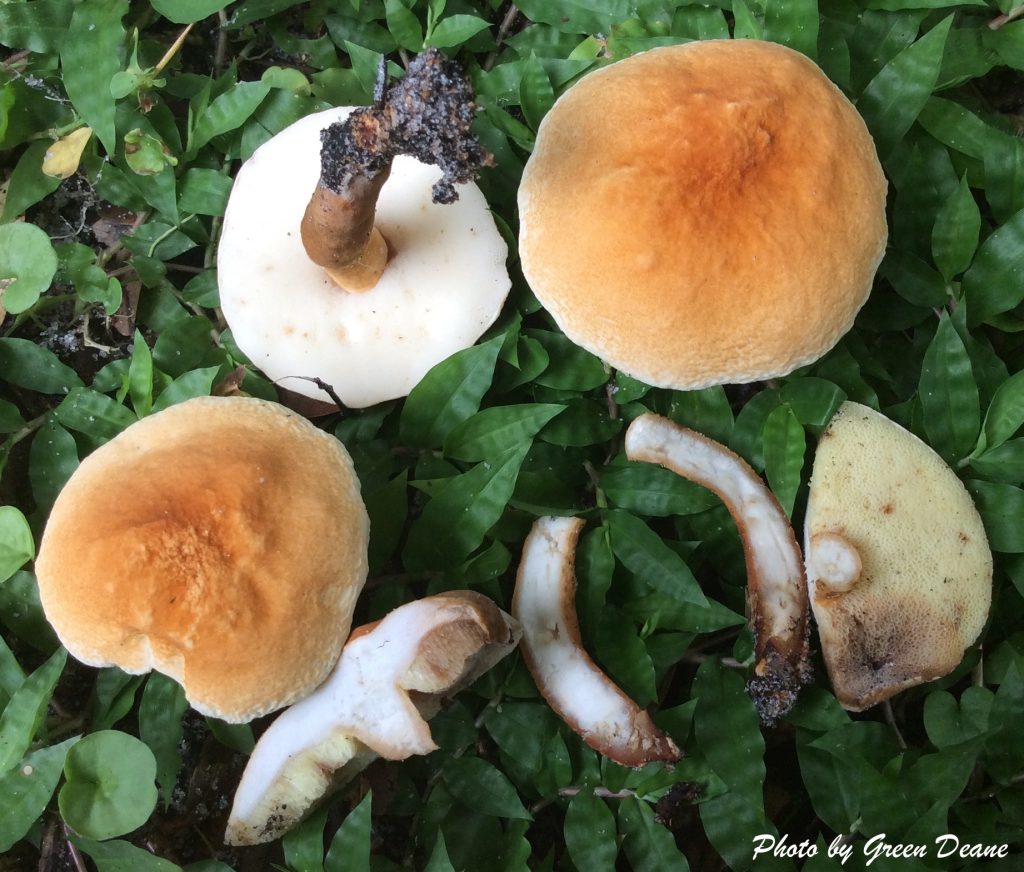
One of the surprises we had at Ft. Meade — besides seeing some quail — was a Chestnut Bolete. The surprise was not that it was there but that it was there now. We are situated between mushroom seasons though rain these last two weeks and warming ground temperatures are changing that. Indeed, today I saw my first Chanterelle of the season. I picked two and will have them with scrambled eggs in the morning. This also means the traffic on the five mushroom Facebook pages I started and moderate will increase. Edible Mushrooms Florida only has edible mushrooms posted on it. Florida Mushroom Identification Forum has over 4,000 members and several published authors. It’s a good page to get local mushrooms identified quickly. Southeastern U.S. Mushroom Identification is for the southeast United States and has a couple of thousand members. Edible Wild Mushrooms is very general and broad. The Orlando Mushroom Group is how local mushroom hunters exchange information, photos, and plan field trips. We have to schedule one in late June or early July.

Upcoming foraging classes: The class schedule is set out to the end of June. this weekend they are in West Palm Beach in Dreher Park, always an interesting location. Sunday’s class is at Lake Woodruff. This class is held only a couple of times per year. It involves a lot of walking, close to four miles and there is no running water. You must carry a good amount with you. Also this is more wild Florida so there are less weeds of civilization there but more native species.
Saturday, May 11th, Dreher Park, 1200 Southern Blvd., West Palm Beach, 33405. 9 a.m to noon. Meet just north of the science center in the north section of the park.
Sunday, May 12th, Lake Woodruff National Wildlife Refuge, 2045 Mud Lake Road, DeLeon Springs, FL. 9 a.m. to noon. A few hundred feet after crossing the railroad tracks on Mudlake Road there in the parking lot on your right. We meet there. This is a hike of approximately four miles, two out and back mostly native species, very few ornamentals. While the walking is easy we are exposed to the elements, sun on a clear day, wind on a cold day. Check the weather, dress appropriately. Bring water, wear suitable footwear. Know that as it is federal land it can be closed anytime for any reason without notice.
Saturday, May 18th, Florida State College, south campus, 11901 Beach Blvd., Jacksonville, 32246. 9 a.m. to noon. We will meet at building “D” next to the administration parking lot.
Sunday, May 19th, Boulware Springs Park, 3420 SE 15th St., Gainesville, FL 32641. 9 a.m. to noon. Meet at the picnic tables next to the pump house.
Saturday, May 25th, Blanchard Park, 10501 Jay Blanchard Trail, Orlando, FL 32817. 9 a.m. to noon. Meet next to the tennis courts by the YMCA building.
Sunday, May 26th, Eagle Park Lake, 1800 Keene Road, Largo, FL 33771. 9 a.m. to noon. Meet at the pavilion near the dog park.
Saturday, June 1st, Bayshore Live Oak Park, Bayshore Drive. Port Charlotte. 9 a.m. to noon. Meet at the parking lot at the intersection of Bayshore Road and Ganyard Street. 9 a.m. to noon.
Sunday, June 2nd, Wickham Park: 2500 Parkway Drive, Melbourne, FL 32935-2335. 9 a.m. to noon.Meet at the “dog park” inside the park.
Saturday June 8th, Wekiva State Park, 1800 Wekiwa Circle, Apopka, Florida 32712. 9 a.m. to noon. Arrive early as there will be a lot of people wanting to go to the springs to swim. There is a park admission Fee: $6 per vehicle. Limit 8 people per vehicle, $4 for a single occupant vehicle, $2 pedestrians or bicyclists. Meet at the Sand Lake parking lot (road on left after entrance. Go to end of road.) Unlike city parks or the urban area, Wekiva Park is “wild” Florida. There are very few weeds of urbanization. The edibles are mostly native plants and far between. There is a lot of walking in this class.
Sunday, June 9th, Red Bug Slough Beneva Road, Sarasota, FL, 34233. 9 a.m. to noon. Meet at the parking lot.
Saturday, June 15th, Eagle Park Lake, 1800 Keene Road, Largo, FL 33771. 9 a.m. to noon. Meet at the pavilion near the dog park.
Sunday, June 16th, Ft. Desoto Park, 3500 Pinellas Bayway S. St. Petersburg Fl 33715. Meet at the parking lot of the fishing pier, northeast end of the parking lot. 9 a.m. to noon. There is a fee to get into the park. The fishing pier is about halfway along the SW/NE road along the southern end of the park. There is only one fishing pier. This is also father’s day so perhaps you can go fishing or swimming after class. High tide is at noon that day at the park. Also that evening at 7:15 pm. there is a “shoot the full moon” event at the park. It is to watch the full moon rise between the Sunshine Skyway Spans.
Saturday, June 22nd, Blanchard Park, 10501 Jay Blanchard Trail, Orlando, FL 32817. 9 a.m. to noon. Meet next to the tennis courts by the YMCA building.
Sunday, June 23rd, Spruce Creek Park, 6250 Ridgewood Ave. Port Orange, 32127. GPS: N 20°05’35.4″ W080°58′.26.2″ 9 a.m. to noon. Meet at the pavilion.
Saturday June 29th: Ft. Meade Outdoor Recreation Area, 1639 Frostproof Highway, Fort Meade, FL 33841. (Frostproof Highway is also Route 98.) 9 a.m to noon. Meet at the brown bathrooms in the middle of the park which is due south from the highway. (Not the tan bathrooms near the intersection.)
To learn more about the classes go here.
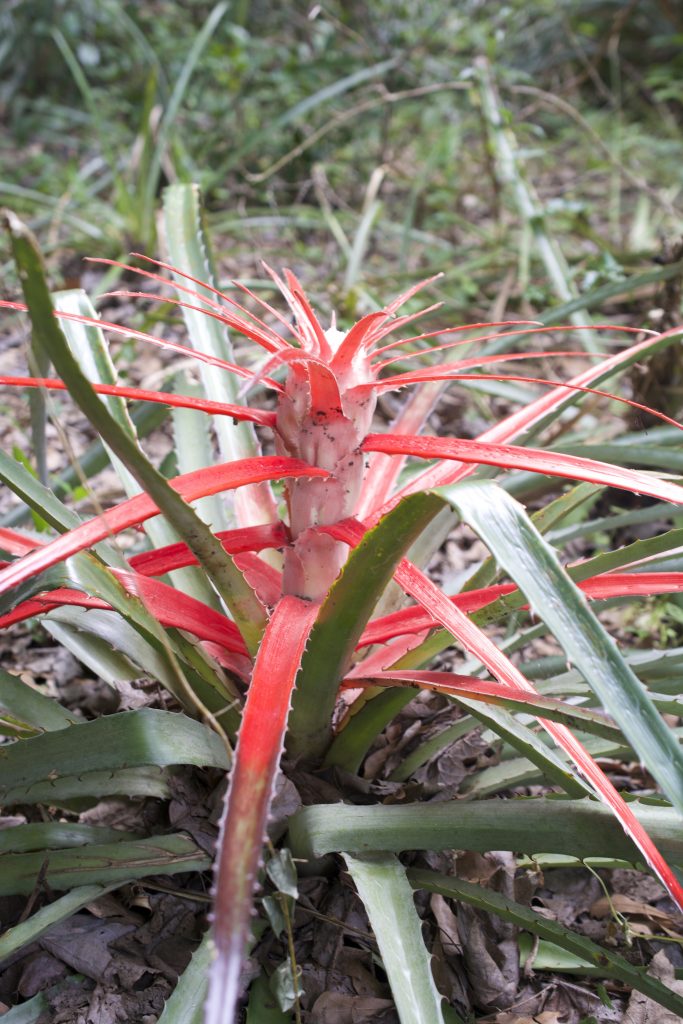
As the season changes several species are beginning to grow. Three we saw this past weekend in Cassadaga were Kudzu, Wild Pineapple, and Winged Yams. Nearly all part of the Kudzu are edible except the seeds. The plant, unfortunately, suffers from a texture issue and when in blossom smells like a room of third graders all chewing cheap grape bubble gum. A good solution is to let goats eat Kudzu. They love it producing quality milk and subsequently cheese. Blossoming now, and in a very different way, is Wild Pineapple. It was planted for its attractiveness around old resorts and posh homes. The leaves turn scarlet and white, very stunning. The fruit is something of a let down, edible but with precautions. Some folks can eat them without issue other not so. But they are high in vitamin C. Also beginning to climb up are the yams with edible roots. The invasive “Air Potato” and the Winged Yam are about six weeks apart. The invasive one comes up first in the spring and fades first in the fall. The Winged Yam comes up late in comparison. This weekend we found several Winged Yams starting their seasonal run. We also dug out one of the roots for a look see. If you were hungry it would have provided a lot of food. And if you look around carefully now you can also find Persimmons fruiting.
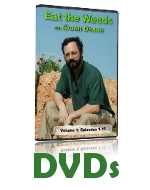
All My Videos are available for free on You Tube. They do have ads on them so every time you watch a Green Deane video I get a quarter of one cent. Four views, one cent. Not exactly a large money-maker but it helps pays for this newsletter. If you want to see the videos without ads and some in slightly better quality you can order the DVD set. It is nine DVDs with 15 videos on each for a total of 135 videos. Many people want their own copy of the videos or they have a slow service and its easier to order then to watch them on-line. The DVDs make a good gift for that forager you know especially as spring is … springing. Individual DVDs can also be ordered or you can pick and choose. You can order them by clicking on the button on the top right hand side of this page (if your window is open wide enough.) Or you can go here.
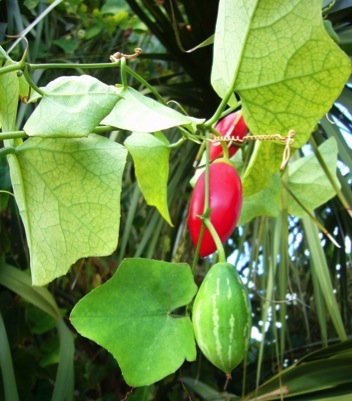
If you have an established Ivy Gourd you know what this entry will be about: They are fruiting now and will do so until cold weather some seven months from now. The Ivy Gourd has a schizophrenic status. It’s an escaped Asian vegetable that grows well locally and is nearly pest free. It seems resistant to most virus and fungus but is attacked for about now for three weeks by some lava. I just cut them out and eat the rest. Because the Ivy Gourd is so prolific and resistant it’s popular with home gardeners and permaculturists. On the other side of the issue, as it is not native it is on the radar of the Native Plant Society and the state as an invasive. I personally don’t know how invasive it is because while it’s available but I don’t see it too often in my wanderings. I find it an excellent vegetable, either when green or ripe red. It will probably grow in popularity as more and more people start growing their own food. You can read about Ivy Gourd here.

Donations to upgrade EatTheWeeds.com have gone well. Thank you to all who have contributed to either via the Go Fund Me link, the PayPal donation link or by writing to Green Deane POB 941793 Maitland FL, 32794.
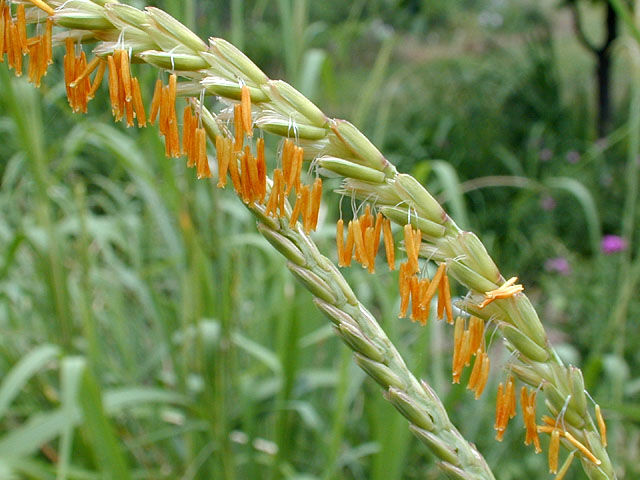
Grass and ice cream are usually not considered at the same time unless it is Eastern Gamagrass. Why? Because livestock like the clumping Tripsacinae so much cattlemen call in Ice Cream Grass. While it can be used like wheat it’s a distant relative of corn. Eastern Gamagrass is sod forming and can reach up to eight-feet tall. Though it is pollinating now locally the grass can seed from June to September. As you can tell from photo to the right the male flowers occupy the top three-fourths of the spike and the female flowers the bottom fourth. In this species the girls are brown, hair-like structures. Besides fodder Eastern Gamagrass is a common ornamental found in parks and residential areas. A bunch can live to be 50 years old or more To read more about Eastern Gamagrass go here.

Want to identify a plant? Looking for a foraging reference? Do you have a UFO, an Unidentified Flowering Object you want identified? On the Green Deane Forum we chat about foraging all year. And it’s not just about warm-weather plants or just North American flora. Many nations around the world share common weeds so there’s a lot to talk about. There’s also more than weeds. The reference section has information for foraging around the world. There are also articles on food preservation, and forgotten skills from making bows to fermenting food. One special section is “From the Frightening Mail Bag” where we learn from people who eat first then ask questions later. You can join the forum by clicking on “forum” in the menu.
This is weekly issue 354.

